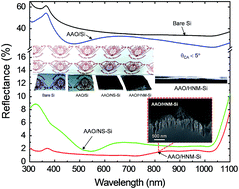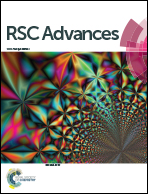A multifunctional hierarchical nano/micro-structured silicon surface with omnidirectional antireflection and superhydrophilicity via an anodic aluminum oxide etch mask†
Abstract
We fabricated hierarchical nano/micro (HNM) architectures on a silicon (Si) surface for efficient antireflection. To form the micropyramid (MP) structures on the Si surface, a potassium hydroxide-based wet etching process was carried out. Meanwhile, for the nanostructures (NS), an anodic aluminum oxide (AAO) film with nanopores as an etch mask was used, followed by an inductive coupled plasma (ICP) etching process. To obtain optimized structures with efficient antireflection, the etching was performed under different process conditions including RF power, ICP power, process pressure, gas flow rate, and etching time. The AAO/NS-Si largely reduced the reflectivity of bare Si over a wide wavelength range of 300–1100 nm, showing an average reflectance (Ravg) value of 3.4% (i.e., Ravg = 38% for the bare Si). The AAO/HNM-Si consisting of NS/MP arrays had a lower reflectance spectrum than 2% at wavelengths of 300–1050 nm, exhibiting an Ravg value of 1.5%. Superior antireflection characteristics were also observed in the wide light incident angle range of 20–70° at wavelengths of 300–1100 nm. For theoretical analysis, reflectance calculations were also performed by a rigorous coupled-wave analysis simulation, which indicated a similar trend to the experimental results. For surface wetting behavior, it revealed a superhydrophilic surface with water contact angles of < 5°.


 Please wait while we load your content...
Please wait while we load your content...